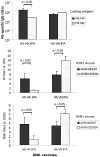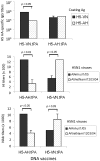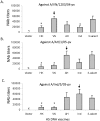Polyvalent DNA vaccines expressing HA antigens of H5N1 influenza viruses with an optimized leader sequence elicit cross-protective antibody responses
- PMID: 22205966
- PMCID: PMC3244406
- DOI: 10.1371/journal.pone.0028757
Polyvalent DNA vaccines expressing HA antigens of H5N1 influenza viruses with an optimized leader sequence elicit cross-protective antibody responses
Abstract
Highly pathogenic avian influenza A (HPAI) H5N1 viruses are circulating among poultry populations in parts of Asia, Africa, and the Middle East, and have caused human infections with a high mortality rate. H5 subtype hemagglutinin (HA) has evolved into phylogenetically distinct clades and subclades based on viruses isolated from various avian species. Since 1997, humans have been infected by HPAI H5N1 viruses from several clades. It is, therefore, important to develop strategies to produce protective antibody responses against H5N1 viruses from multiple clades or antigenic groups. In the current study, we optimized the signal peptide design of DNA vaccines expressing HA antigens from H5N1 viruses. Cross reactivity analysis using sera from immunized rabbits showed that antibody responses elicited by a polyvalent formulation, including HA antigens from different clades, was able to elicit broad protective antibody responses against multiple key representative H5N1 viruses across different clades. Data presented in this report support the development of a polyvalent DNA vaccine strategy against the threat of a potential H5N1 influenza pandemic.
Conflict of interest statement
Figures







Similar articles
-
A triclade DNA vaccine designed on the basis of a comprehensive serologic study elicits neutralizing antibody responses against all clades and subclades of highly pathogenic avian influenza H5N1 viruses.J Virol. 2012 Jun;86(12):6970-8. doi: 10.1128/JVI.06930-11. Epub 2012 Apr 11. J Virol. 2012. PMID: 22496212 Free PMC article.
-
Cocktail of H5N1 COBRA HA vaccines elicit protective antibodies against H5N1 viruses from multiple clades.Hum Vaccin Immunother. 2015;11(3):572-83. doi: 10.1080/21645515.2015.1012013. Hum Vaccin Immunother. 2015. PMID: 25671661 Free PMC article.
-
Co-administration of certain DNA vaccine combinations expressing different H5N1 influenza virus antigens can be beneficial or detrimental to immune protection.Vaccine. 2012 Jan 11;30(3):626-36. doi: 10.1016/j.vaccine.2011.11.017. Epub 2011 Nov 23. Vaccine. 2012. PMID: 22119588
-
A consensus-hemagglutinin-based DNA vaccine that protects mice against divergent H5N1 influenza viruses.Proc Natl Acad Sci U S A. 2008 Sep 9;105(36):13538-43. doi: 10.1073/pnas.0806901105. Epub 2008 Sep 2. Proc Natl Acad Sci U S A. 2008. PMID: 18765801 Free PMC article.
-
Human COBRA 2 vaccine contains two major epitopes that are responsible for eliciting neutralizing antibody responses against heterologous clades of viruses.Vaccine. 2020 Jan 22;38(4):830-839. doi: 10.1016/j.vaccine.2019.10.097. Epub 2019 Nov 14. Vaccine. 2020. PMID: 31733946
Cited by
-
A Review of DNA Vaccines Against Influenza.Front Immunol. 2018 Jul 9;9:1568. doi: 10.3389/fimmu.2018.01568. eCollection 2018. Front Immunol. 2018. PMID: 30038621 Free PMC article. Review.
-
A cGAS-Independent STING/IRF7 Pathway Mediates the Immunogenicity of DNA Vaccines.J Immunol. 2016 Jan 1;196(1):310-6. doi: 10.4049/jimmunol.1501836. Epub 2015 Nov 20. J Immunol. 2016. PMID: 26590319 Free PMC article.
-
Profiles of acute cytokine and antibody responses in patients infected with avian influenza A H7N9.PLoS One. 2014 Jul 8;9(7):e101788. doi: 10.1371/journal.pone.0101788. eCollection 2014. PLoS One. 2014. PMID: 25003343 Free PMC article.
-
Codon-Optimized P1A-Encoding DNA Vaccine: Toward a Therapeutic Vaccination against P815 Mastocytoma.Mol Ther Nucleic Acids. 2017 Sep 15;8:404-415. doi: 10.1016/j.omtn.2017.07.011. Epub 2017 Jul 13. Mol Ther Nucleic Acids. 2017. PMID: 28918040 Free PMC article.
-
A polyvalent influenza DNA vaccine applied by needle-free intradermal delivery induces cross-reactive humoral and cellular immune responses in pigs.Vaccine. 2016 Jul 12;34(32):3634-40. doi: 10.1016/j.vaccine.2016.05.030. Epub 2016 May 19. Vaccine. 2016. PMID: 27211039 Free PMC article.
References
-
- Chen H, Smith GJ, Zhang SY, Qin K, Wang J, et al. Avian flu: H5N1 virus outbreak in migratory waterfowl. Nature. 2005;436:191–192. - PubMed
-
- Abdel-Ghafar AN, Chotpitayasunondh T, Gao Z, Hayden FG, Nguyen DH, et al. Update on avian influenza A (H5N1) virus infection in humans. N Engl J Med. 2008;358:261–273. - PubMed
Publication types
MeSH terms
Substances
Grants and funding
LinkOut - more resources
Full Text Sources
Medical

